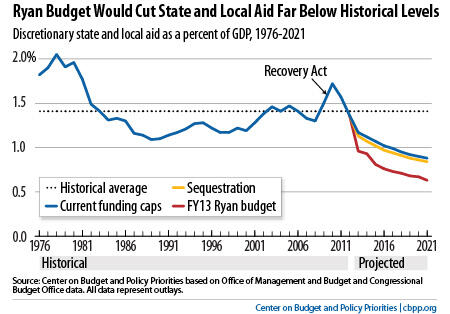más allá de los números
Unbalanced Deficit-Reduction Package Would Slash Funds to States and Localities
As we explain in a new analysis, a deficit-reduction plan that lacks significant revenues would almost certainly deeply cut federal funds that support states and localities as they educate children, build roads and bridges, protect public health, and provide law enforcement.
Policymakers generally agree that we need a substantial deficit-reduction package to keep the national debt from growing faster than the economy. They also agree broadly that cuts in Social Security and Medicare that affect current beneficiaries should be limited and that defense spending should not be cut below the spending caps imposed by last summer’s Budget Control Act (BCA). Those choices would leave federal support for states and localities as one of the few remaining potential sources of large savings.
The House-passed budget from Budget Committee Chairman Paul Ryan is an example of the sort of approach Congress likely would take if it rejects a balanced approach to deficit reduction that includes significant revenues. Consider some of the effects such a plan could have on state and local funding:
- The Ryan budget would heavily shift costs to states by cutting Medicaid funding. It would cut federal funding for Medicaid by 34 percent by 2022 (relative to what federal Medicaid funding for states would be under current law), and by steadily larger amounts in years after that.
- The Ryan budget would cut funding for a wide range of other state and local services, as well. The Ryan budget also would cut non-defense “discretionary” (i.e. non-entitlement) funding by 22 percent in 2014 and later years, on top of the substantial cuts imposed by the BCA spending caps. About one-third of this category of funding goes for grants to state and local governments to support services that states and localities provide, such as education, law enforcement, water treatment facilities, and disaster response.
If funding for these grants to state and local governments is cut by 22 percent, in line with the cut to overall non-defense discretionary funding, states and localities would lose about $28 billion in 2014. (This does not include additional cuts the Ryan budget would make to transportation funding.)
- Funding for state and local services would likely fall far below historical levels under the Ryan budget cuts. The Ryan budget cuts would be much deeper that the automatic cuts (or “sequestration”) scheduled to begin in January. By 2021, the Ryan budget would reduce discretionary state and local grants to an estimated 0.6 percent of GDP, less than half the average of the last 35 years (see graph).

Cuts of this magnitude would force states and localities to reduce the quality and reach of their basic public systems or to raise new revenue or cut other programs to continue meeting these needs. Either way, the result would be a huge cost shift from the federal government to states and localities. By contrast, a balanced deficit-reduction plan that includes significant new revenues almost certainly would lessen the resulting cost shift to states and localities.
Click here to read the full paper, which includes state-by-state estimates of the size of these cuts.
